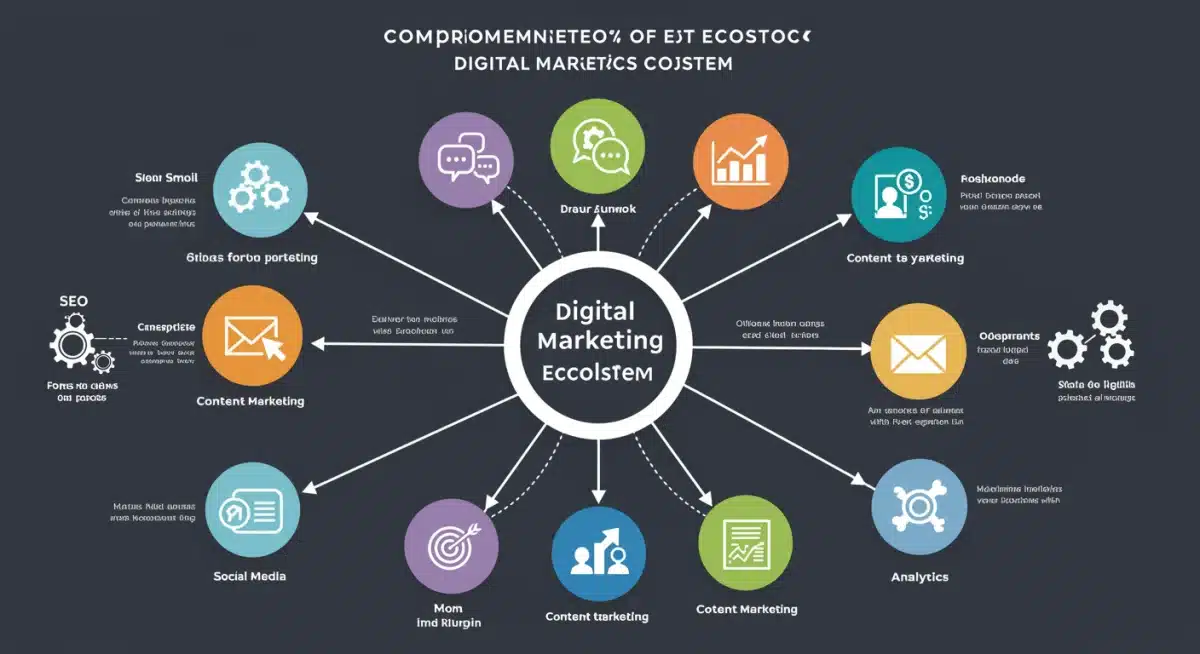Building a Robust Digital Presence: 7-Step Strategy for US Startups

Building a Robust Digital Presence: A 7-Step Strategy for US Startups in the Current Market (PRACTICAL SOLUTIONS) is no longer optional; it’s a critical imperative for survival and growth. This report provides a timely, actionable framework for new ventures navigating today’s intensely competitive digital landscape.
Understanding the Current Digital Landscape for US Startups
The digital marketplace for US startups has undergone significant shifts in recent months, necessitating a dynamic and responsive approach to online visibility. As of late 2023 and early 2024, consumer behaviors are evolving rapidly, with increased reliance on digital channels for discovery, research, and purchasing. Startups must grasp these nuances to effectively carve out their niche.
Recent data indicates a surge in online competition, driven by both established players and a continuous influx of new ventures. This environment demands not just presence, but strategic, optimized presence. Startups failing to adapt risk being overlooked in a saturated market, highlighting the urgency for a well-defined digital strategy.
Key Market Trends Impacting Digital Presence
- Increased Mobile Usage: A dominant factor, with a majority of online interactions now occurring on mobile devices, demanding mobile-first design and optimization.
- AI-Powered Search and Personalization: Search engine algorithms are becoming more sophisticated, prioritizing personalized experiences and relevant, high-quality content.
- Evolving Social Media Algorithms: Platforms continually update their algorithms, requiring brands to be agile in their content creation and engagement strategies to maintain reach.
- Data Privacy Regulations: Heightened consumer awareness and stricter regulations (e.g., California Consumer Privacy Act) necessitate transparent data handling and privacy-centric marketing.
These trends underscore the need for a comprehensive and adaptable strategy when building a robust digital presence. Ignoring them can lead to wasted resources and missed opportunities in a market that rewards agility and foresight.
Step 1: Define Your Digital Identity and Target Audience
Establishing a clear digital identity and precisely identifying your target audience forms the bedrock of any successful digital presence strategy. Without this foundational understanding, marketing efforts become scattered and ineffective. Startups must articulate their unique value proposition and who they aim to serve with laser focus.
This initial step involves introspection and market research to ensure alignment between the startup’s offerings and the needs of its potential customers. A well-defined digital identity resonates with the target audience, fostering trust and recognition in a crowded online space.
Crafting Your Brand Narrative Online
Your brand narrative is the story you tell about your startup, its mission, and its values. This narrative must be consistent across all digital touchpoints, from your website to social media profiles. It needs to be authentic and engaging to capture attention.
- Mission and Vision: Clearly articulate what your startup stands for and what future it aims to create.
- Unique Selling Proposition (USP): Highlight what makes your product or service distinctly better or different from competitors.
- Brand Voice and Tone: Establish a consistent communication style that reflects your brand’s personality and resonates with your audience.
Simultaneously, pinpointing your target audience goes beyond demographics. It involves understanding their pain points, aspirations, online behaviors, and preferred communication channels. This deep understanding informs every subsequent step in building a robust digital presence.
Step 2: Develop a High-Performance Website (Your Digital Hub)
Your website serves as the central hub of your digital presence, acting as your 24/7 storefront, information center, and conversion engine. For US startups, a high-performance website is non-negotiable; it must be fast, secure, user-friendly, and optimized for both search engines and mobile devices. This is where potential customers form their first, and often lasting, impression.
Developing such a website requires careful planning and execution, focusing on both aesthetic appeal and technical performance. A poorly designed or slow website can deter visitors, regardless of the quality of your product or service, directly impacting your ability to establish a strong online footprint.
Essential Website Features for Startups
Beyond basic functionality, certain features are crucial for a startup’s website to thrive in today’s market. These elements contribute to a seamless user experience and support your marketing objectives.
- Responsive Design: Ensures optimal viewing and interaction across all devices, from desktops to smartphones.
- Intuitive Navigation: Users should easily find what they’re looking for, with clear menus and logical site structure.
- Call-to-Actions (CTAs): Strategically placed and compelling CTAs guide visitors towards desired actions, such as signing up or making a purchase.
- Robust Security (SSL): Essential for protecting user data and building trust, particularly for e-commerce or data collection.
Furthermore, content on your website must be high-quality, relevant, and regularly updated. This includes informative product/service pages, a compelling ‘About Us’ section, and a blog for consistent content marketing. A well-maintained website is a dynamic asset in building a robust digital presence.
Step 3: Implement Strategic SEO and Content Marketing
Search Engine Optimization (SEO) and content marketing are intertwined disciplines essential for driving organic traffic and establishing authority online. For US startups, a strategic approach to these areas ensures visibility in search results and positions the brand as a thought leader. It’s about being found by the right people at the right time.
Effective SEO involves technical optimization, keyword research, and quality backlink building. Content marketing, on the other hand, focuses on creating valuable, relevant, and consistent content to attract and retain a clearly defined audience. Together, they form a powerful engine for digital growth.
SEO Fundamentals for Startup Visibility
Startups often overlook the critical role of SEO in their early stages, but foundational optimization can yield significant long-term benefits. Focusing on core elements can dramatically improve search engine rankings.
- Keyword Research: Identify terms and phrases your target audience uses to search for solutions you offer.
- On-Page SEO: Optimize page titles, meta descriptions, headings, and image alt text with relevant keywords.
- Technical SEO: Ensure your site is crawlable, mobile-friendly, and loads quickly.
- Local SEO (if applicable): Optimize for local searches, especially for brick-and-mortar or service-based startups.
Complementing SEO, content marketing involves creating blog posts, articles, videos, infographics, and other formats that educate, entertain, or inspire your audience. This content should naturally incorporate your target keywords and be distributed across relevant channels. Consistently publishing high-quality content is vital for building a robust digital presence that attracts and engages.

Step 4: Leverage Social Media for Brand Building and Engagement
Social media platforms offer US startups unparalleled opportunities for brand building, direct customer engagement, and community creation. However, simply having a presence is not enough; a strategic approach tailored to each platform and your target audience is crucial. The goal is to foster meaningful interactions, not just accumulate followers.
Choosing the right platforms is key. Not every startup needs to be on every social media channel. Instead, identify where your target audience spends their time and focus your efforts there, creating content that resonates with their specific interests and behaviors.
Developing an Engaging Social Media Strategy
An effective social media strategy goes beyond posting updates; it involves listening, interacting, and analyzing performance to continually refine your approach. Consistency and authenticity are paramount.
- Platform Selection: Focus on 1-3 platforms most relevant to your audience (e.g., LinkedIn for B2B, Instagram/TikTok for visual brands, Twitter for news/discussions).
- Content Calendar: Plan and schedule diverse content (text, images, video) to maintain a consistent posting rhythm.
- Community Management: Actively respond to comments, messages, and mentions to foster a loyal community.
- Influencer Collaborations: Partner with relevant micro-influencers to expand reach and build credibility within your niche.
Utilizing social media analytics to track engagement, reach, and conversions allows startups to optimize their strategy over time. This data-driven approach ensures that social media efforts contribute directly to building a robust digital presence that supports business objectives.
Step 5: Implement Email Marketing for Nurturing Leads and Customers
Email marketing remains one of the most effective and cost-efficient digital marketing channels for US startups. It provides a direct line of communication with your audience, allowing for personalized messaging, lead nurturing, and relationship building. Unlike social media, you own your email list, providing a stable asset for long-term engagement.
The power of email lies in its ability to deliver targeted content, promotions, and updates directly to interested individuals. It’s an invaluable tool for moving prospects through the sales funnel and retaining existing customers, significantly contributing to the overall strength of your digital presence.
Building and Engaging Your Email List
Successful email marketing starts with building a quality list of subscribers who are genuinely interested in your offerings. This requires ethical practices and compelling incentives.
- Lead Magnets: Offer valuable content (e.g., e-books, webinars, exclusive discounts) in exchange for email addresses.
- Opt-in Forms: Strategically place clear and concise opt-in forms on your website and landing pages.
- Segmentation: Divide your list into segments based on interests, behaviors, or demographics to send more relevant emails.
Once you have a list, the focus shifts to engaging your subscribers with valuable content. This includes welcome sequences for new subscribers, newsletters with industry insights, product updates, and exclusive offers. Personalized and consistent communication through email marketing is crucial for building a robust digital presence that converts and retains customers.
Step 6: Utilize Paid Advertising for Accelerated Growth
While organic strategies like SEO and content marketing build long-term authority, paid advertising offers US startups an immediate and scalable avenue for accelerated growth. Platforms like Google Ads, social media ads (Facebook, Instagram, LinkedIn), and display networks can quickly drive targeted traffic, generate leads, and boost sales. It’s about putting your message in front of the right audience precisely when they are most receptive.
However, paid advertising requires careful budgeting, strategic targeting, and continuous optimization to ensure a positive return on investment (ROI). A haphazard approach can quickly deplete resources without yielding desired results, making a data-driven strategy essential.
Crafting Effective Paid Ad Campaigns
The success of paid advertising hinges on highly targeted campaigns, compelling ad copy, and relevant landing pages. Each element must work in concert to maximize efficiency and conversions.
- Platform Selection: Choose ad platforms where your target audience is most active and receptive to your message.
- Audience Targeting: Leverage detailed demographic, interest, and behavioral targeting options to reach ideal customers.
- Compelling Ad Copy & Creatives: Develop engaging headlines, descriptions, and visuals that grab attention and convey your value proposition.
- Landing Page Optimization: Ensure your ad clicks lead to highly relevant, conversion-focused landing pages.
Regular monitoring of campaign performance, A/B testing different ad creatives and copy, and adjusting bids are critical for maximizing the effectiveness of your paid advertising spend. When executed strategically, paid ads are a powerful tool for accelerating the process of building a robust digital presence and achieving rapid market penetration.
Step 7: Monitor, Analyze, and Adapt Your Digital Strategy
The final, yet continuous, step in building a robust digital presence for US startups is the ongoing process of monitoring, analyzing, and adapting your digital strategy. The digital landscape is constantly evolving, and what works today may not be effective tomorrow. A data-driven approach ensures that your efforts remain optimized and yield the best possible results.
This involves regularly reviewing key performance indicators (KPIs) across all your digital channels, identifying trends, and making informed adjustments. Without this continuous feedback loop, even the most well-planned strategy can become outdated and ineffective, leading to wasted resources and missed opportunities.
Key Metrics for Digital Performance Analysis
Understanding which metrics to track is fundamental for effective analysis. These insights provide a clear picture of what is working and where improvements are needed across your digital footprint.
- Website Traffic: Monitor unique visitors, page views, bounce rate, and time on site to understand user engagement.
- Conversion Rates: Track sign-ups, purchases, or lead generations to measure the effectiveness of your calls to action.
- Social Media Engagement: Analyze likes, shares, comments, and reach to gauge audience interaction and content resonance.
- Email Open & Click-Through Rates: Assess the effectiveness of your email campaigns in reaching and engaging subscribers.
- ROI of Paid Ads: Calculate the return on investment for all paid campaigns to optimize spending.
Tools like Google Analytics, social media insights, and email marketing platform analytics provide the data necessary for this ongoing evaluation. By consistently monitoring performance, analyzing results, and adapting your strategies, US startups can ensure their digital presence remains strong, relevant, and effective in achieving their business objectives.
| Key Strategy | Brief Description |
|---|---|
| Digital Identity & Audience | Clearly define brand values and target customers to guide all digital efforts. |
| High-Performance Website | Develop a fast, secure, mobile-friendly site as the central digital hub. |
| SEO & Content Marketing | Drive organic traffic and establish authority through optimized, valuable content. |
| Monitor & Adapt | Continuously analyze data and adjust strategies for ongoing optimization. |
Frequently Asked Questions About Digital Presence for Startups
A robust digital presence is vital for US startups to compete effectively, reach target audiences, build credibility, and drive growth in a market increasingly dominated by online interactions and digital discovery. It ensures visibility and facilitates direct customer engagement.
The most important first step is clearly defining your digital identity and target audience. Understanding who you are as a brand and who you want to reach guides all subsequent strategic decisions, ensuring focused and effective marketing efforts.
Startups can leverage social media effectively by focusing on 1-2 relevant platforms, creating authentic and engaging content, actively interacting with their community, and exploring micro-influencer collaborations, rather than trying to be everywhere at once.
Yes, email marketing remains highly relevant. It provides a direct, owned channel for lead nurturing, personalized communication, and building long-term customer relationships, often yielding a high return on investment for startups.
Data analysis is crucial for continuously optimizing your digital presence. By monitoring KPIs, startups can identify what works, adapt strategies to changing market conditions, and ensure resources are allocated effectively for sustained growth and relevance.
What Happens Next
As US startups continue to navigate an increasingly complex digital ecosystem, the strategies outlined here are not static; they represent a continuous cycle of implementation, analysis, and adaptation. The market is expected to see further innovations in AI-driven personalization and immersive digital experiences in the coming months. Startups that prioritize agility and a data-centric approach to their digital presence will be best positioned to capture market share and sustain long-term growth. Expect increased competition for digital attention, making these practical solutions even more critical for new ventures aiming to thrive.





